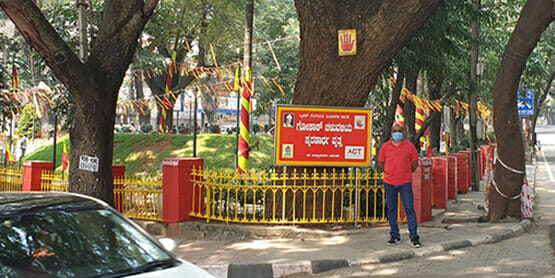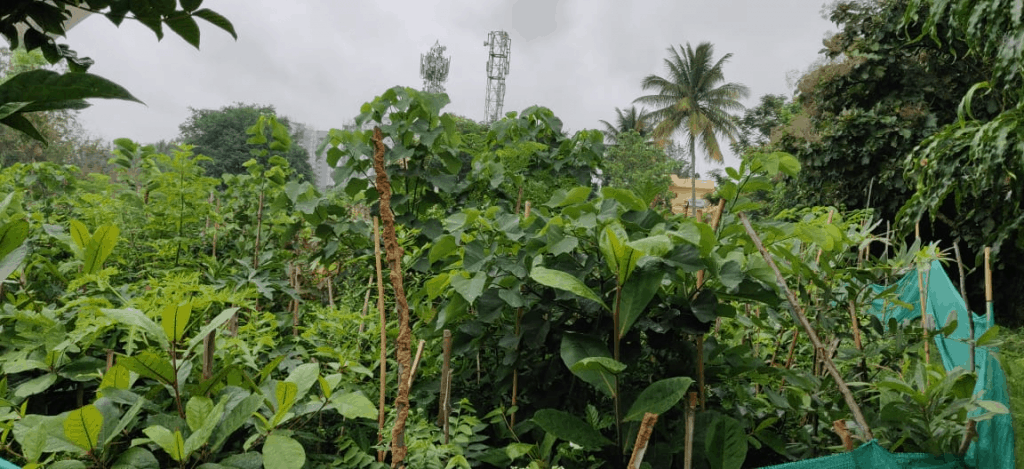Parks seem like uncontroversial public spaces, but dig a little deeper, and you will find that even these apparently benign spaces are deeply political. They are often the settings for decisions and manoeuvrings that become evident only when you probe into their provenance, functioning and upkeep.
These three examples serve to demonstrate how public spaces have been taken over by political forces. Unfortunately, most of us citizens prefer to demur to the situation, forgetting that it is our money that is used to create and run these amenities. We forget to question, or to wonder, if there were a different way to use precious public space. Here is an attempt to do that:
Park 1
This park sits bang in between three very busy roads. It is triangular, fairly small, and access to the park is not easy. In the past, it was used by the casual visitor who might have had a few moments to spare before boarding his bus, or by a vegetable vendor who wanted a few moments of rest before resuming her work, or perhaps by those who had just nipped across from the busy shopping street to rest their legs.
It transformed almost overnight into a park with prim and proper planting, benches, a pathway, even an amphitheatre – all thanks to its rebirth as a park to commemorate an important political event. The park had a grand inauguration, speeches were made, and it was opened to the public. Except that it was never open. Every time one passed by, there was a big lock on the gate. Months, even years have passed by. The park is barely used, despite the lovely ambience, despite even free Wifi being offered within its walls! In a city starved for lung space, how is this even possible?

One reason is that it sits across from Sankey tank, and anyone who wants a good stroll will just nip across the road and enjoy a better ambience. The other reason is that, for all purposes, it is just a traffic island sitting in the middle of three busy roads. You can expect to be constantly assaulted by sounds of honking and exhaust fumes. Why would anyone in their right minds even sign up for that? We already experience it every day on our streets.
Better solution: It could have been converted into an urban (Miyawaki type) forest or grove with traditional trees and herbaceous plants. A dense clump of trees and shrubs in this spot would have helped absorb the exhaust generated by traffic. It could have served as a roosting spot for birds – a just compensation for the shrinking tree cover in the vicinity.

Read more: Saaku — Enough Is enough–residents stage protest walk to reclaim Malleswaram
Park 2
You will find this park next to the only traffic circle that still exists in Malleswaram. It used to be a small, nondescript park until a few years ago. But consider this – it is the only park in a ward that has a population of approximately 35,000 people. The World Health Organization (WHO) suggests a minimum of about 100 sq ft of urban green space per person. This little park measures about 5,000 sq ft. Do the math!
A few years ago, it was ‘neatened’ and a small open-air gym was set up inside the park, and quite a few residents started using it regularly. This park is also a popular hangout for a local college two streets away, and so it became a well-used space. Barring a little wear and tear, and the dislocation of some tiles on the walking path, there was nothing wrong or wanting in the park. But the BBMP (with political blessings) decreed otherwise.
Last year, the boundary wall was ripped out, the large chapadi coping stones broken down (Ah! Where can one find those anymore….), all the benches removed, and the paving dug up. In its place, a wall was made with the stones that had been cut to size. On top of that, an oversized metal grill barricade was erected. The grill was also erected along the entire stretch of the existing compound walls of two houses adjacent to the park – an entirely unwarranted expense. In this process, two trees were strangulated between the grill and the wall. We were told that the grill has the same design as the one used near the Vidhana Soudha. The state legislature resembles an open jail and is most certainly not a model for a small residential park.
Residents had requested face to face seating, where they could TALK to each other – request denied. Residents had requested that the central area be grassed over where little children could play – request denied. Residents had requested for a garbage bin so that the trash thrown by the college kids could be collected at one place – request denied.
Better solution: The park could have been left as is, with minimal improvements made to the flooring. Composting bins could have been installed to convert the huge leaf litter generated by the trees in the park into compost, to be used again in the park. Without grills to obscure the view of the park, all those living nearby could have kept an eye on it. It could have become a friendly adda that every neighbourhood so desperately needs in these times.
Park 3
This park is situated very close to a busy shopping street. With its dense foliage, and play structures, it is a haven for those who work there or shop there. Except for a small problem. It has been closed for more than a decade due to a court case regarding the intended conversion of the park into a – wait for this – a parking lot. And not just any regular parking lot, but a multi-level car park, or an MLCP. Residents and shop owners in the vicinity of this park are clear that this plan is neither well-thought out nor practical, but the BBMP feels it is worth fighting for. Who suffers? The common man. In a city gasping for lung space, citizens have been denied access to this crucial green space. Instead, the park is now a hangout for unsocial elements, who have taken advantage of its neglect by making it their own.
Better solution: The park could have, instead, become a hangout for shoppers and residents, with small tables and benches set up so they could have lunch or tiffin between shopping. Perhaps a small stage could have been constructed where local cultural programs could be showcased in the evenings or during festivals. An area could have been earmarked for local craftsmen to sell their wares on a rotating basis. In a nutshell, this could have become a lively and refreshing space for the community, vendors and for visitors, instead of lying neglected and misused for decades.
Read more: Concretising open parks — this is not the development people want or need
Public space is for the public
All around the city we see similar strange anomalies. There are parks filled with play equipment, lying unused, because there is a diktat from above to keep them closed and inaccessible to residents. There are parks that have money thrown at them with abandon, inaugurated with pomp and ceremony, filled with statues, and lying unused, because they were created for political reasons, and not for serving the public. There are neglected parks, crying to be rejuvenated, but lying outside the radar of the administration because they belong to the ‘wrong’ neighbourhoods. There are parks that are being quietly turned into built up spaces. Countless others are being swallowed up in the name of development. Some beloved parks have been bequeathed with such a long laundry list of Don’ts that citizens have stopped visiting them.
The three instances offer just a glimpse into what ails a typical neighbourhood in our city. At the root of all these problems lie a few simple questions. For whom are these green spaces created? With what purpose were they created? What are the basic essentials for a park? Who are the custodians? Who decides what they should become?
Green spaces like parks, wetlands, tree cover, groves etc are crucial for a city. Our ambivalent relationship with them, our docile acceptance of what is doled out to us, our failure to recognise the devious nexus of political ambitions and administrative kowtowing, and our failure to speak up for our needs, has led to this situation.
Bengaluru used to be called a Garden city at one point of time. Is it not high time we reclaimed the title before it gets completely erased from public memory?